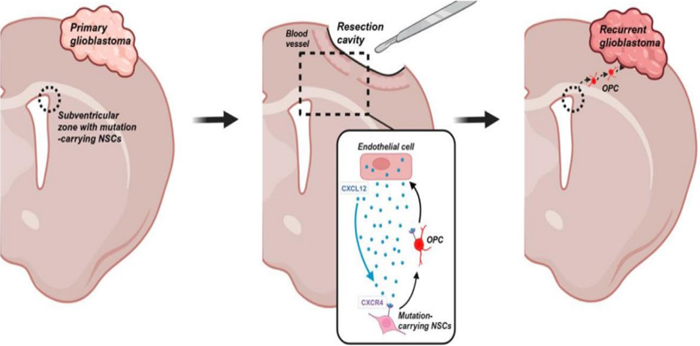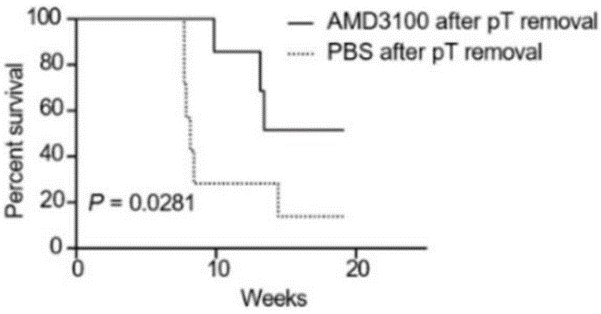Cause of Glioblastoma Recurrence Identified, Neural Stem Cell Mechanism Revealed
- Joint research team of SNUH, Yonsei Cancer Hospital, and KAIST, proved it through Genome Analysis and Mouse Experiment
- Dual Fluorescence Mouse Model Confirmed that Neural Stem Cells Play an Important Role in Recurrent Cancer Formation
- Neural stem cell and tumor reconstruction mechanism identified... Proven that blocking this mechanism improves survival rate by 60-70%

[Figure 1] Schematic diagram of the mechanism of glioblastoma neural stem cells with the mutated genes that cause cancer are located deep in the brain. Even when the primary tumor is surgically removed (center), signals secreted by vascular endothelial cells stimulate neural stem cells to migrate to the recurrence site. In recurrent glioblastoma (right), the migrated neural stem cells form recurrent tumors
Glioblastoma (GBM) is the most common malignant brain tumor in adults and in most cases reoccurs after surgery. Existing treatments have limitations in their capacity to prevent relapse, making this disease a well-known as a brain tumor that is very difficult to treat. Recently, a joint research team from Seoul National University Hospital(SNUH), Yonsei Cancer Hospital, and Korea Advanced Institute of Science and Technology (KAIST) discovered that the source of glioblastoma relapse may originate from neural stem cells (NSCs) in the subventricular region. The results of this study, which demonstrated the mechanism of glioblastoma relapse and suggested the possibility of developing a treatment targeting neural stem cells, were published in the latest issue of the international academic journal ‘Molecular Cancer’ (IF=27.7).
Even if as much as possible of the tumor is removed through surgery, most glioblastomas relapse, and relapses occur mainly near the surgical site. Since existing treatments such as surgery, radiation therapy, and chemotherapy have limitations in preventing this, it has become urgent to clearly identify the mechanism of glioblastoma relapse. Based on previous research that revealed that neural stem cells (cells with the ability to generate new nerve cells in the brain) in the subventricular region are the source of tumor development, the research team focused on the possibility that neural stem cells play an important role in relapse.
A joint research team consisting of Professor Lee Joo Ho's team (first author, Dr Li Xue) in the Department of Radiation Oncology at SNUH, Professor Kang Seok-Gu's team in the Department of Neurosurgery at Yonsei Cancer Hospital, and Professor Lee Jeong Ho's team at the KAIST announced on March 12 that, using genome analysis and a mouse model, they had experimentally proved the hypothesis that recurrent cancer may not simply arise from residual cancer tissue but may originate from distant neural stem cells.
The research team analyzed the genetic relationship between the primary and recurrent tumors in 10 patients with glioblastoma and discovered that in 60% of patients, the recurrent tumors were genetically unassociated with the primary tumors, and instead, the recurrent tumors were associated with the ventricular region neural stem cells. This finding is an important indicator that neural stem cells may be the origin of recurrent tumors.
In addition, the research team conducted an experiment using a dual-fluorescence mouse model to trace the origin of recurrent cancer. By labeling neural stem cells and tumor cells with different fluorescent proteins, they were able to trace the origin of the tumor. Through this, the research team clarified the process by which neural stem cells migrate to the recurrent site after surgery and form new tumors. This is an important result that proves that neural stem cells play an important role in the formation of recurrent cancer.

[Figure 2] As a result of blocking the process of recurrent cancer development in neural stem cells in a mouse model, the survival rate of the treatment group (solid line) improved by 60-70% compared to the control group (dotted line).
The research team additionally discovered that the CXCR4/CXCL12 pathway induces the migration of neural stem cells and plays an important role in tumor restructuring. The CXCL12 signaling molecule is secreted from vascular endothelial cells at the surgical resection site and binds to the CXCR4 receptor to attract neural stem cells to the surgical site and induces their migration; the mechanism was elucidated through mouse experiments. The research team demonstrated that blocking this mechanism can reduce the recurrence rate and improve the survival rate by 60-70%. This finding suggests that therapies targeting CXCR4/CXCL12 may play an important role in preventing the recurrence of glioblastoma.
Professor Lee Joo Ho (Department of Radiation Oncology) of SNUH said, “This study is significant in that it newly identifies the cause of glioblastoma recurrence and discovers a mechanism that can block the interaction between the surgical site and neural stem cells, thereby suggesting a new direction for future glioblastoma treatment and research.”
This study was conducted with the support of the National Research Foundation of Korea and the Korea Health Industry Development Institute.

[Pictures from left] SNUH Department of Radiation and Oncology Professor Lee Joo Ho and Dr Li Xue